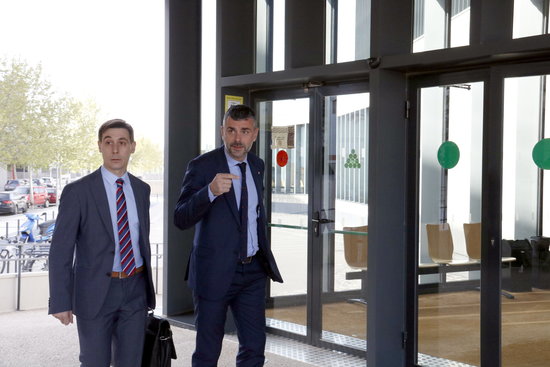Former culture minister testifies in Sixena Case
Santi Vila is investigated in the proceedings involving disputed Romanesque works of art, accused of breach of official duty and disobedience

Santi Vila, former Minister of Culture for the Catalan government, appeared in court today to testify over a contentious case: that of the artwork of Sixena. For not having delivered the art in question to the Aragon monastery, Vila is accused of breach of official duty and disobedience.
Specifically, the government of Aragon claimed ownership over the works of art, and fought for their relocation. Meanwhile, Catalonia disputed this, maintaining that the art was legally bought, with documentation, decades before. But now, with the Catalan government controlled by Madrid, the situation has changed.
Vila is “resigned” to the proceedings, he said
In statements to the press alongside his lawyer, Vila explained that he is “resigned,” regards how he is dealing with the judicial proceedings. Also at court were the mayor of Vilanova de Sixena, Ildefonso Salillas, and his lawyer.
Salillas has been vocal in his demanding the works of art be moved to his city. Indeed, it was he who filed a lawsuit against Vila and his successor in the Catalan government post, Lluís Puig, who replaced him in July 2017.
Accusations could lead to up to 15 years barred from office
Salillas’ lawyer, Jorge Español, explained that if the judge were to rule that there is enough evidence against Vila, repercussions for the separate accusations could entail up to 15 years of suspension from public office, as well as a fine of up to 30,000 euros.
Español also said that the prosecutor would request Vila be held financially responsible for the cost of the police operation to remove 44 of the works of art from Lleida, which was put at a cost of 20,000 euros.
“Everything possible was done,” testified former culture minister
Before the judge, Vila stated that regards the Sixena case, “everything possible was done.” He further noted that the judicial order was “partially” observed.
Regards the hotly disputed items that were in the Lleida Museum, Vila said that he had been faced with a conflict between the judicial requirements, and Catalan government laws to protect the artifacts.
The conflict has become political, expressed Vila
During the testimony, Santi Vila responded to the prosecutor’s questions but denied doing so regards his personal accusation, through questions from Jorge Español. Vila expressed that he hopes the judge will drop charges against him and his successor, Lluís Puig, as he believes that they acted according to the law.
Santi Vila also stated that in his opinion, the conflict has become political, and was judged due to interests outside the cultural field.
A dispute dating back to the Spanish Civil War
The Sixena situation has been ongoing for years, but it truly dates back to the 1936, when, during the Spanish Civil War, the monastery of Sixena was set on fire. That same year, specialists took the art from Aragon to Catalonia, Barcelona, for safekeeping and restoration.
The controversy stems from a disagreement. Catalonia bought the items legally in the 1980s, but Aragon claims that the transaction was outside the law: hence, the courtroom sparring to keep—or reclaim—the artwork, which was largely at the Lleida and MNAC museums.
A change with Article 155
This dispute was carried out over years and largely on equal footing by both parties, until the Spanish government implemented Article 155 in October 2017, the constitutional provision that seized Catalonia’s self-rule and deposed its then-government.
With the Spanish government at the helm of Catalan cultural matters, the Sixena disagreement changed course when the Lleida artworks were removed and taken back to Aragon at the end of 2017, with the very last of it moved in January.
Vila himself was the only member of Puigdemont’s cabinet who was not deposed by Article 155, as he stepped down from his position the day before independence was declared. Still, when it comes to Sixena, he is not untouched by the Spanish constitutional provision. Meanwhile, his successor Lluís Puig, was deposed by Article 155 and is currently facing extradition in Belgium.